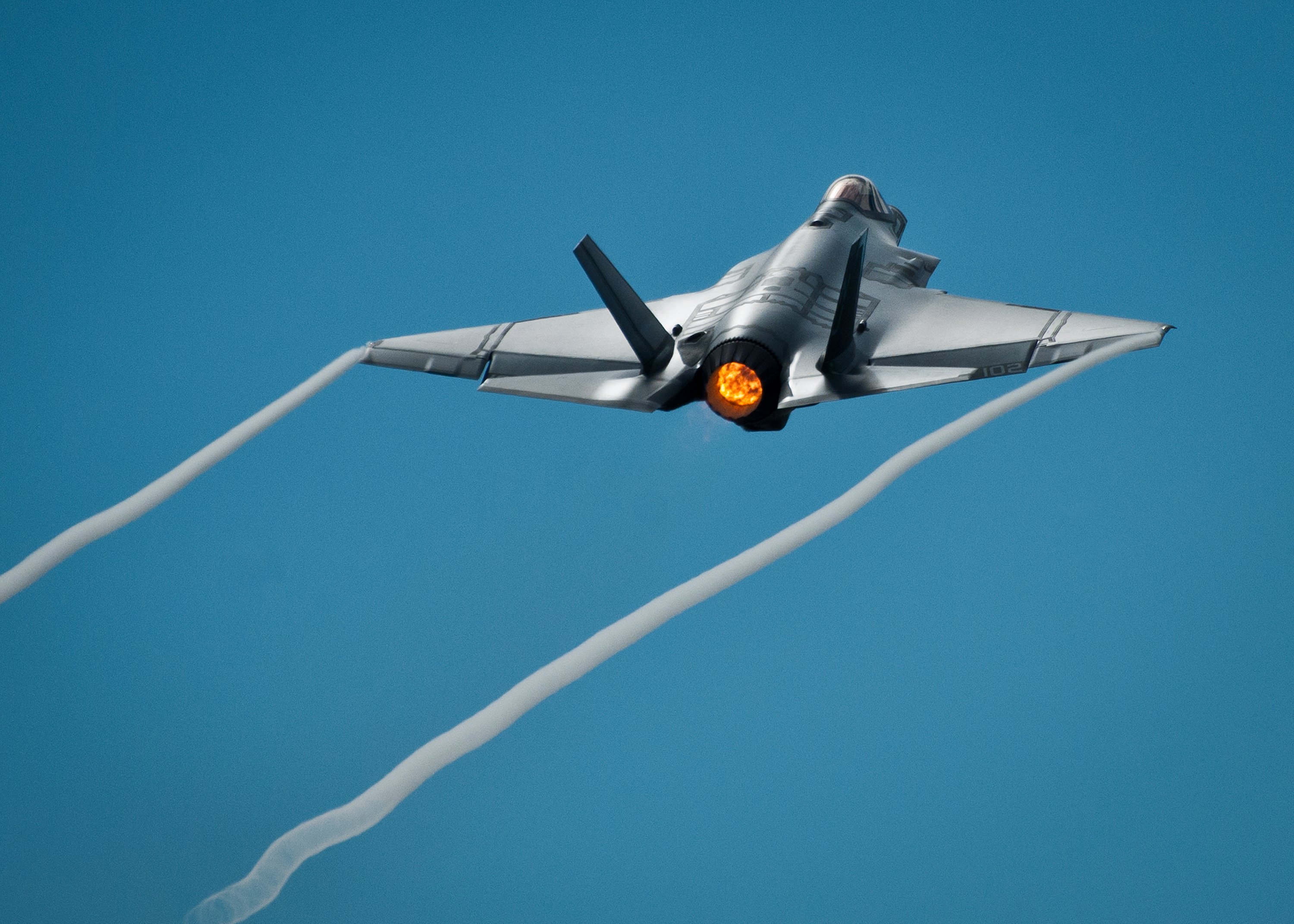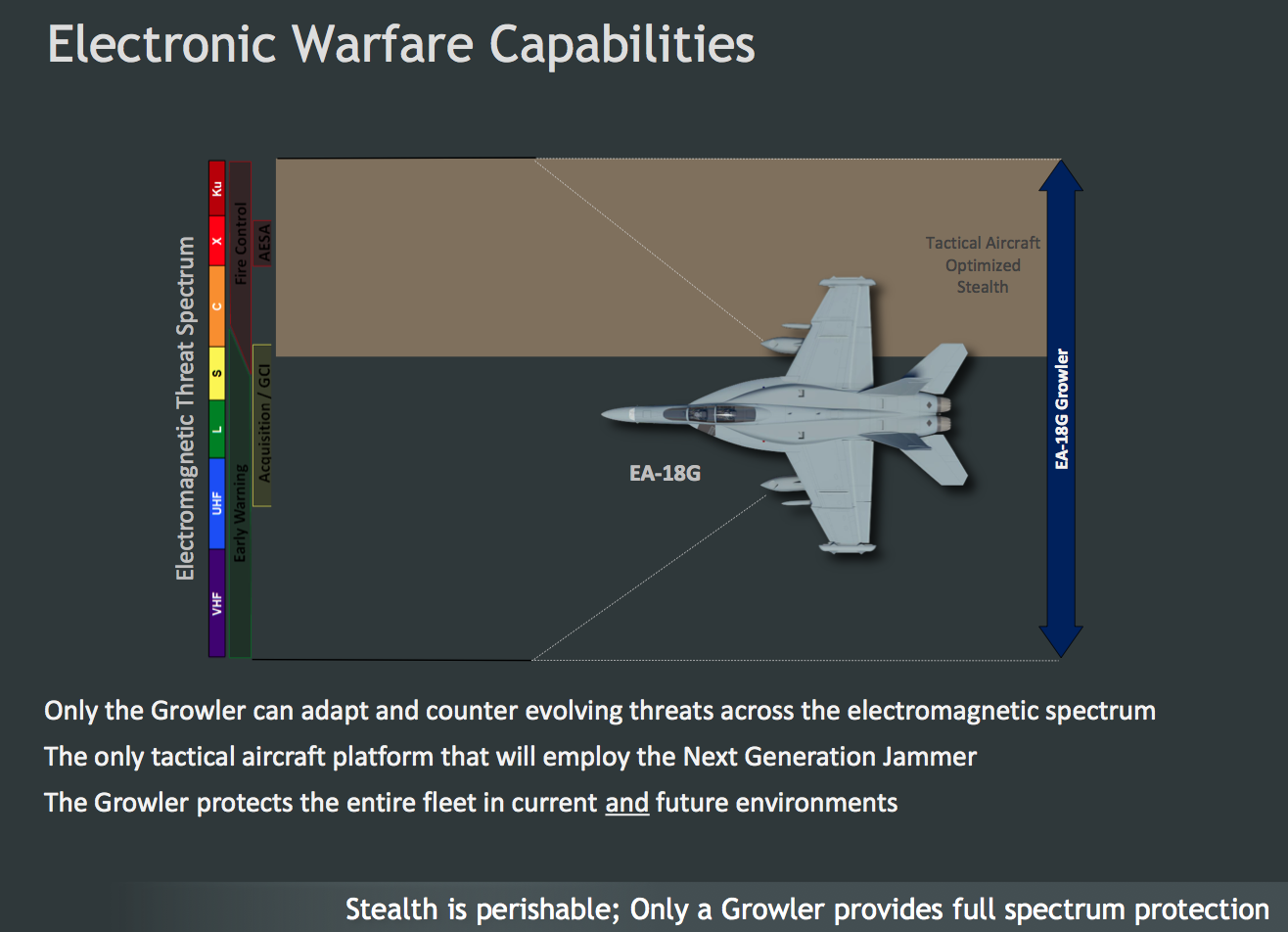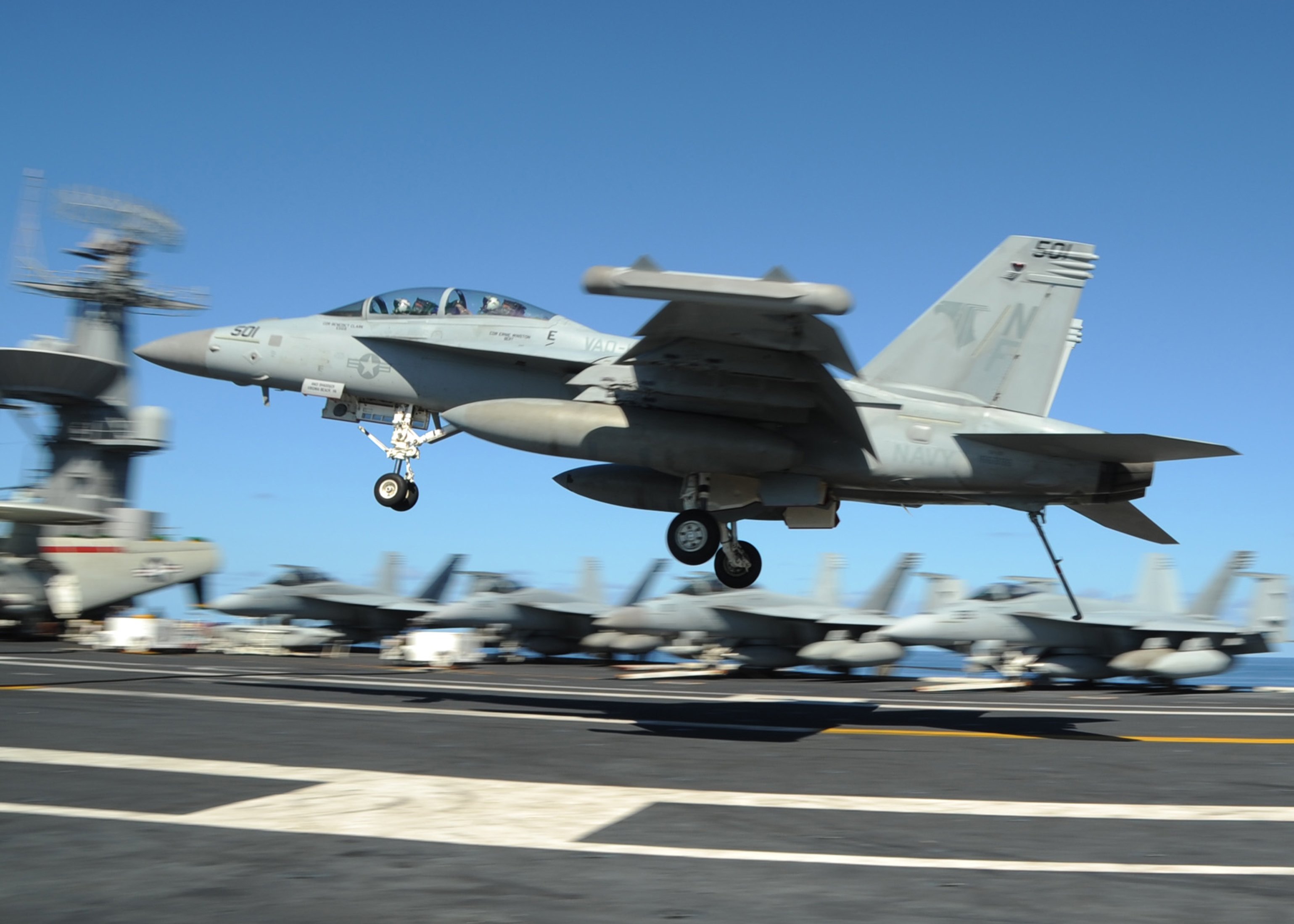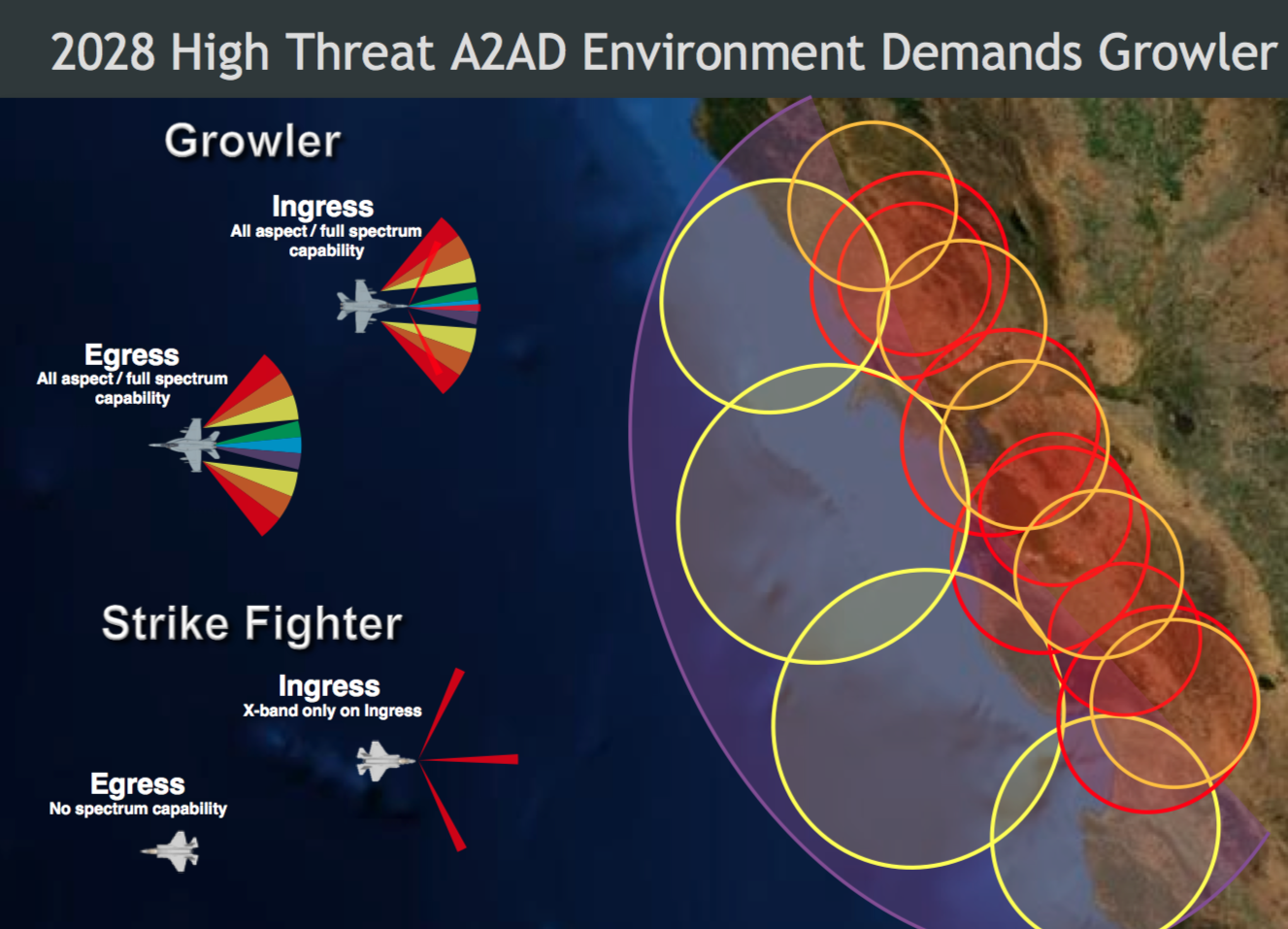
The U.S. Navy will need to use a combination of stealth and electronic warfare capabilities to defeat advanced anti-access/area denial (A2/AD) threats in the future, chief of naval operations Adm. Jonathan Greenert said on April 16 at the U.S. Naval Institute annual meeting in Washington, D.C.
“[Stealth] is needed for what we have in the future for at least ten years out there and there is nothing magic about that decade,” Greenert said. “But I think we need to look beyond that. So to me, I think it’s a combination of having aircraft that have stealth but also aircraft that can suppress other forms of radio frequency electromagnetic emissions so that we can get in.”
Electronic attack by itself will probably not be enough to enable U.S. forces to penetrate enemy air defenses, according to Greenert and multiple U.S. military and industry sources.
“I doubt in the future we can just suppress everything, go rolling in until we do what we need to do and get out,” Greenert said. “But we have the means for—way out in the future—with the Next Generation Jammer and what it’ll bring, to be able to get in when we need to and get out.”
Greenert’s comments largely mirrors a Boeing presentation last week at the Navy League’s Sea, Air and Space exposition where Mike Gibbons, the company’s vice president for the F/A-18E/F and EA-18G programs, had stated that stealth aircraft must be supported by airborne electronic attack capabilities.
“The point is anybody that goes in can’t be good against any one frequency band because you will be seen by others, that’s the key,” Gibbons said. “The Growler is the only aircraft that has that full spectrum sensor and jamming capability to take care of that for strikers.”
The Boeing presentation also reiterated the company’s oft-stated position that low observable technologies are a “perishable” asset—particularly as potential enemies develop advanced low frequency radars and signal processors become ever more capable.

“Stealth is ‘delayed detection’ and that delay is getting shorter. SAM (Surface-to-Air Missile) radars are shifting their frequencies into lower frequency bands where U.S. stealth is less effective,” said Mark Gammon, Boeing’s F/A-18E/F and EA-18G program manager for advanced capabilities, in an emailed statement. “Early warning radars are in the VHF spectrum where stealth has limited if any capability. These radars are networked into the SAM radars giving the SAM radars cued search. The threat is developing out of spectrum sensors like IRST [infrared search and track] systems on their fighters. Stealth has no capability to delay an IRST detection and track.”
While some military officials consulted by USNI News wholeheartedly concurred with Boeing’s assessment, others dismissed the company’s claims out of hand. Many others offered a more nuanced view.
“Boeing is in full-court press against the [Lockheed Martin] F-35 in this briefing. As such, when they describe the advantages of the Growler–which are accurate–they ignore the tradeoff for that advantage,” said one U.S. Air Force official. “The truth is that the Growler and LO [low observable] platforms complement each other extremely well.”
Lockheed Martin officials, however, maintain that the F-35 is able to operate inside highly contested airspace without any support assets.
“By government contract specification, the airplane is required to be able to go into high threat anti-access environments, autonomously perform its mission and survive,” said Eric Van Camp, Lockheed’s domestic F-35 business development director. “The results of flight test indicate conclusively that the airplane will meet that contract specification.”

While it is an indisputable fact that a tactical fighter-sized stealth aircraft must be optimized to defeat higher-frequency bands such the C, X and Ku bands as a simple matter of physics, in a real world operational setting, there are often other factors involved that make detecting and tracking a stealth aircraft more difficult.
Industry, Air Force and Navy officials agreed that there is a “step change” in an LO aircraft’s signature once the frequency wavelength exceeds a certain threshold and causes a resonant effect.
Typically, that resonance occurs when a feature on an aircraft—such as a tail-fin — is less than eight times the size of a particular frequency wavelength.
Effectively, small stealth aircraft that do not have the size or weight allowances for two feet or more of radar absorbent material coatings on every surface are forced to make trades as to which frequency bands they are optimized for.
“You can’t be everywhere at once on a fighter-sized aircraft,” said another Air Force source.
What that means is that a radar operating at a lower frequency band such as parts of the S or L band—like civilian air traffic control (ATC) radars — might be able to detect and possibly even track certain stealth aircraft to an extent.
However, a larger stealth aircraft like the Northrop Grumman B-2 Spirit, which lacks many of the features that cause a resonance effect, is much more effective against low-frequency radars than, for example, an F-35.
But those lower-frequency radars do not provide what Pentagon officials call a “weapons quality” track needed to guide a missile onto a target.
“Even if you can see an LO strike aircraft with ATC radar, you can’t kill it without a fire control system,” an Air Force official said.
Meanwhile, Russia, China and others are developing advanced UHF and VHF band early warning radars that use even longer wavelengths in an effort to cue their other sensors and give their fighters some idea of where an adversary stealth aircraft might be coming from.
But the problem with VHF and UHF band radars, as one U.S. Navy official told USNI News, is that with long wavelengths come large radar resolution cells.
That means that contacts are not tracked with the required level of fidelity to guide a weapon onto a target.
“Does the mission require a cloaking device or is it Ok if the threat sees it but can’t do anything about it?” the Navy official asked rhetorically.
Further, officials from the Air Force, Navy and Marine Corps agreed that while aircraft like the F-35 or F-22 are not solely relying on low observables for survivability—stealth is an absolute requirement to survive in an A2/AD environment even with airborne electronic attack support.
As one Air Force official explained, stealth and electronic attack always have a synergistic relationship because detection is about the signal to noise ratio. Low observables reduce the signal, while electronic attack increases the noise. “Any big picture plan, looking forward, to deal with emerging A2/AD threats will address both sides of that equation,” he said.
Air Force and Marine Corps officials took exception to Boeing pointing out that the F-35 only has X-band electronic attack coverage from the front. “Aft coverage may or may not be provided onboard any given fighter, but is provided by the package overall — which will likely include EA-18s,” one Air Force official pointed out.
However, Air Force and Marine Corps officials said that the Growler may not be particularly useful against emerging threats and noted that there are electronic warfare upgrades planned for the F-35 in addition to its baseline capability.
“The Growler itself, while a very credible aircraft, has limited suitability in an advanced A2/AD area,” one Air Force official said.
“While it is the state of the art for now, I don’t know if it will be the appropriate jamming platform for the pictured environment.”
Nonetheless, a number of Air Force officials expressed support for the Pentagon potentially increasing the size of its Growler buy. “The Growler is a great asset, we probably need more, and it is an important part of a strike package into an advanced IADS [integrated air defense system],” one official said. “It is not as stand-alone as Boeing will claim.”
However, those same officials pointed out that the Growler is not fully interoperable with joint forces.
“If there is a major enduring shortfall to the Growler, it’s the degree and fidelity between it and other joint suppression platforms. The reasons for which could be as benign as joint interoperability [being seen] as an afterthought,” one Air Force official said.
But “it’s to Boeing’s advantage to propagate a limited interoperability platform, especially one that doesn’t communicate very well with competitor’s platforms in the SEAD/DEAD [suppression of enemy air defenses/destruction of enemy air defenses] mission. But it doesn’t make sense from a warfighter position.”
An industry source agreed that the Growler still faces interoperability problems when operating with Air Force assets, but that is true of many platform across the board. “There are interoperability issues across a lot of the platforms,” the industry source said. For example, Lockheed F-22s are only able to connect with other Raptors using the Intra-Flight Data-Link (IFDL), while the F-35 uses a Joint Strike Fighter-only Multifunction Advanced Data-Link (MADL). “This is one of the bigger issues the Air Sea Battle Office is attempting to resolve,” the industry source said.
Gammon defended the EA-18G’s ability to operate with other Pentagon assets. “Growlers have Link 16 which is compatible with [the] F/A-18 Super Hornet and F-35, E-2D, F-15, F-16, and most of the bombers,” he said. “The good news is the Growlers can stand-off from the threat, build the EM [electromagnetic] picture, and pass weapons quality tracks to the other fighters via Link-16 (and soon TTNT [Tactical Targeting Network Technology]).”
The industry source noted that while the F-35 will be fitted with the Link-16 datalink, it would not be able to use that omni-directional link inside a high threat environment because it could compromise the aircraft’s position. “Aircraft such as the F-35 that might not want to transmit on their Link-16 can always receive Link-16 tracks from Growlers and employ weapons on those tracks,” the industry source said.
Air Force officials conceded that the Pentagon probably needs more EA-18Gs.
“In truth, we never bought enough Growlers in the first place,” one Air Force official said.
“They’re worth their weight in gold, and contribute immensely to the ES [electromagnetic spectrum] situational awareness and EA [electronic attack] communities. But the LIMFAC [limiting factor] is, and always will be, the carrier deck park and cycle times.”

A Navy official said that the carrier deck cycle would be a limiting factor only if the Growler was being used to launch missiles such as the AGM-88E Advanced Anti-Radiation Guided Missile (AARGM) or the High-speed Anti-Radiation Missile (HARM). The official noted that with aerial refueling it is not unheard of for Navy fighters to remain airborne for more than six hours at a time. “If the Growler was kinetic, launching all its HARM and then needing to reload… Yes, the deck cycle time would come into play here,” the official said. “But, it’s more realistic to provide standoff jamming than launch HARMs unless in a self-protect role.” The official also pointed out that the need to land, refuel, swap crews, and perform maintenance at some regulated interval is a requirement for any aircraft.
Boeing also suggested in its presentation that the Growler could be used in the counter-air and strike roles. Gammon elaborated on how Boeing envisions the EA-18G might perform some of those missions—distancing the company’s position somewhat from the diagrams shown in the presentation. “In the counter-air mission, the Growlers will use their ESM [electronic support measures] system to help the fighters detect, and just as important, ID the threat. They can do this from a stand-off position from the fighters and still contribute to the overall SA [situational awareness] and ID,” Gammon said.
Gammon also clarified the company’s position with regard to using the EA-18G in the air-to-ground strike role. “In the strike mission, the Growler is supporting by building that enemy EM order of battle, find, fix, track, and ID those threat emitters and then quarterback the EM fight and determine which of those threat systems we are going to jam, attack, avoid. The Growler can employ weapons such as the AARGM at those emitters as well as handing off that track to a strike fighter to engage.”
Navy officials had said that while the service might consider using the Growler as a battle manager, it is extremely unlikely the service would ever consider using the EA-18G in a direct strike role or the air superiority role where the jet would be the primary shooter.
An industry source conceded that while the Growler would likely never be used as an air superiority fighter or strike aircraft, it could play an important role in those missions. “I do agree that Growlers will not be bringing JDAMs [Joint Direct Attack Munition] to a target,” the source said. “They will support the strike fighters as they fight their way into the target area.”
Though there is broad support for purchasing additional Growlers, it is not a stand-alone solution for dealing with advanced A2/AD threats.
“Stealth has its flaws, as the brief points out; however, if a new pod on a fourth gen platform was a workable answer against the modern and future IADS, I’m about 100 percent certain that USAF [U.S. Air Force] would be trying to buy a pile of them as well,” an Air Force official said.
“But the juice ain’t worth the squeeze, as they say.”





